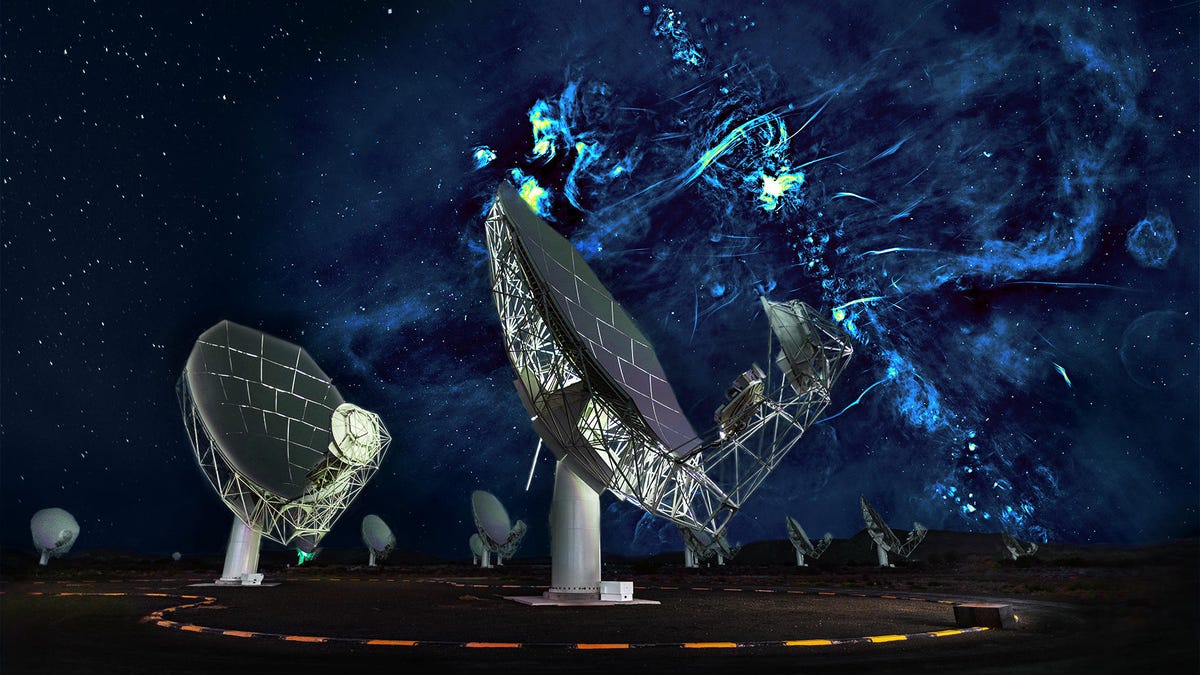Gigantic radio-emitting bubbles discovered at the center of our galaxy
They're hundreds of light years tall.

A radio image of the center of the Milky Way is the background in this composite illustration for a portion of the MeerKAT telescope array in the foreground. The radio bubbles extend from between the two nearest antennas to the upper right corner.
The center of our galaxy is super weird, and it just became weirder thanks to the discovery of two of the largest structures ever observed in the Milky Way. Scientists say they've discovered a pair of "radio-emitting bubbles" that stretch hundreds of light-years tall, forming a sort of cosmic hourglass dwarfing everything else in the galactic center.
"Our radio observations mainly reveal the walls of the bubbles (think of the surface of a balloon) which have been inflated by an energetic event near the black hole at the center of the Milky Way," Fernando Camilo, chief scientist at the South African Radio Astronomy Observatory (SARAO), told me. "Inside the bubbles is hot gas."
The discovery is the first major published finding made using the new SARAO MeerKAT telescope, a 64-dish array that launched in July 2018.
To picture what researchers see, you need to know that Earth isn't located near the middle of the Milky Way; we're actually on the Orion Arm, about 26,000 light years from the galaxy's core. And that's pretty awesome for us because that core is dominated by a very active and hungry black hole with a mass of four million suns.
But it turns out the Milky Way's prime galactic glutton can also create some pretty bizarre sights in the process of gobbling up whatever comes too close.
Near that central void are some massive, energetic structures shooting off radio emissions that have previously been described by scientists as "filaments." These narrow structures tens of light years tall were first seen in the 1980s and have remained something of a mystery.
Now an international team of scientists has another piece to the puzzle: the radio filaments are almost completely enclosed by the two giant balloons Camilo describes.
"The Milky Way's central black hole can - from time to time - become uncharacteristically active, flaring up as it periodically devours massive clumps of dust and gas," explained Ian Heywood of the University of Oxford. "It's possible that one such feeding frenzy triggered powerful outbursts that inflated this previously unseen feature."
Heywood and Camilo are both co-authors of a study published Wednesday in the journal Nature.
William Cotton, a co-author and astronomer with the US National Radio Astronomy Observatory, adds that a massive burst of star formation sending shockwaves through our galactic center could also have been the trigger. Whatever it was, the powerful event happened a few million years ago and led to the creation of signals we can pick up today.
"In effect, this inflated bubbles in the hot, ionized gas near the galactic center, energizing it and generating radio waves that we eventually detect here on Earth."
The researchers say studying some of the bizarre things happening at the center of our own galaxy can help us understand how stars and galaxies evolve in our cosmic neighborhood, as well as across the universe.
It's also yet another reason to stay the heck away from all black holes.

